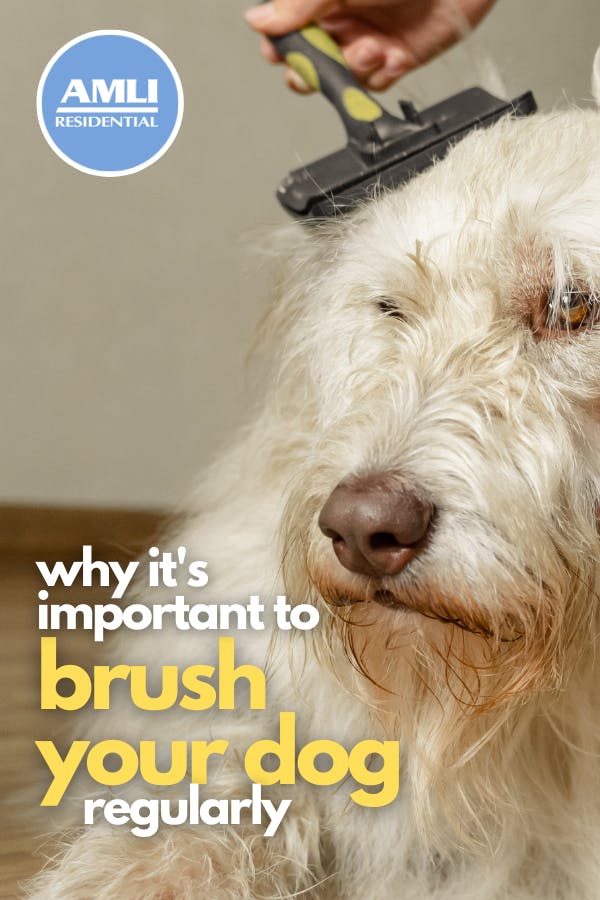We love to look after our four-legged friends! When they are happy, we are happy, and part of keeping them happy and healthy is brushing their fur regularly.
Whether you have a long-haired dog, a short-haired dog, a seasonal shedder or a year-round furball, it’s important to keep up with brushing your dog so that their skin and fur remains healthy. It’s especially important if you have a very active dog or if you have a long-haired dog.
Why it’s important to groom your dog’s fur
It prevents matting
One of the biggest reasons dog owners start regularly brushing their dogs’ fur is to prevent matting.
Matted fur on a dog can be more than just unsightly — it can be downright painful for the dog, especially since dogs can’t do anything about it themselves. Mats form when fur is mixed with dirt, dead skin, oils and friction, and they most often occur on the undersides and behind the legs of long-haired dogs where movement and dirt interact more often. These tufts of fur, dead skin and oils can be prime breeding grounds for fleas and parasites, which in turn can lead to disease.
Here are some of the long-haired dog breeds that require regular brushing:
- Poodle
- Bichon Frise
- Samoyed
- Siberian Husky
- Lhasa Apso
- Shih Tzu
- Yorkshire Terrier
- Cockapoo
- Maltese
- Komondor
- Cocker Spaniel
- Afghan Hound
Brushing your long haired-dog regularly can keep mats at bay, as well as the issues that come along with them. If you can’t brush your entire dog everyday, then try to focus on target areas like the belly and legs.
It reduces the amount of shedding you’ll find around the house
Brushing your pup often means that you get most of that shedding fur out in one go, which in turn means less of it is scattered around your house! The more often you brush, the less fur on your couch… simple as that!
It gives you a chance to check their skin for abnormalities
Brushing your dog gives you a chance to check their skin for any abnormalities and to keep track of any change in existing ones.
Here are a few things you can keep an eye out for on your pup’s skin:
- Any redness or discoloration
- Scabs, wounds or lesions (be gentle when brushing around these!)
- Lumps or swelling
- Rashes or inflammation
- Dry or flaky skin
- Scaly or bald patches
If you do notice any of these, then don’t panic. Different skin issues have different symptoms, and the best way to figure out what the issue is is to visit your veterinarian for an accurate diagnosis.
Brushing removes dead skin and dirt
If you think having an itchy scalp is annoying, then imagine having your entire body itch like that!
Brushing your dog regularly can help keep their skin clean by removing any dirt, bugs, dandruff and dead skin that may be irritating your dog. Although it may be tempting to brush your dog’s hair when it’s wet, it will make any dandruff and dirt clump together and stick to the fur, making it painful to remove. Wait until their fur is totally dry before brushing, then you can give them a bath later!
Brushing helps with flea and tick prevention
If you’re brushing your dog regularly, you get on top of any fleas and ticks as soon as they appear and before they start to get really bad.
If you do find any of those pesky pests, the best ways to get rid of them are to use a flea collar, flea medication or a liquid ointment. You can discuss all this with your vet, though, but hopefully you’ll never have to deal with it at all!
It gives you a chance to clean their ears and nails
If you’re already carving out some time to brush your dog’s coat, you might as well spend a few extra minutes cleaning their ears and checking their nails!
It doesn't take much to clean ears, and you can do it in less than a minute with a cotton pad wrapped around your index finger. Gently wipe the outer ear and the visible parts of the ear canal, but don’t go any further. You don’t want to shove anything further down their ear if you can help it!
Nails are also an important thing to keep track of, though not nearly as often for most dogs. Long nails are uncomfortable to walk on, and it can actually change the way dogs step, walk and run! If their gait changes too drastically, it can affect their joints and cause some serious complications down the line.
You don’t need to do this every day, of course, but it’s still important to regularly clean their ears and occasionally check their nails so that you avoid any other issues later on!
Brushing distributes natural oils
Hair follicles secrete natural oils that are great for keeping hair and skin healthy and moisturized. Even our own human hair does that! Cats can keep their coats shiny and smooth by regularly grooming themselves and spreading those oils around, but dogs can't do that and, therefore, require a little help from their owners.
Brushing your pup’s fur will help distribute any natural oils into their fur and around their skin, keeping their coat shiny, healthy and coated in all that good oily stuff!
It’s great for bonding!
Who doesn't love a spa day? Well, many dogs may not like the process of being brushed and groomed, but teaching them to be okay with it is a process that will give you plenty of quality one-on-one time with your pup. Plus, once they learn to like it (or at least tolerate it), it will be even more enjoyable for you!
Good luck!
Pin it!

Featured photo courtesy Pixabay/alektas


 View All Posts by Colleen Ford
View All Posts by Colleen Ford